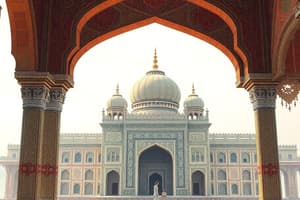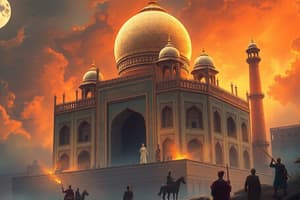Podcast
Questions and Answers
Why was it difficult for later Mughal emperors to maintain control over their mansabdars?
Why was it difficult for later Mughal emperors to maintain control over their mansabdars?
- The _mansabdars_ formed alliances with the Marathas, undermining Mughal power.
- The position of _mansabdar_ was abolished, leading to widespread revolt.
- Successors lacked the leadership and resources to effectively oversee them. (correct)
- The _mansabdars_ were primarily of foreign origin and did not respect Mughal authority.
What was the consequence of governors consolidating control over Mughal provinces?
What was the consequence of governors consolidating control over Mughal provinces?
- Increased cooperation between the governors and the Mughal emperors.
- Increased revenue remission to the Mughal capital.
- Reduced political, economic, and military powers for the governors.
- A decline in the periodic transfer of revenue to the central authority. (correct)
What impact did Nadir Shah's invasion have on Delhi's social structure?
What impact did Nadir Shah's invasion have on Delhi's social structure?
- It resulted in social mobility, with the poor rising to positions of power.
- It caused widespread social disruption, with the wealthy becoming beggars and the revered becoming helpless. (correct)
- It led to the rise of a new merchant class that dominated the city's economy.
- It caused a brief economic boom due to the influx of wealth.
How did factionalism among the nobles affect the Mughal empire?
How did factionalism among the nobles affect the Mughal empire?
What was the role of watan jagirs in the relationship between the Mughals and Rajput rulers?
What was the role of watan jagirs in the relationship between the Mughals and Rajput rulers?
What strategy did the Marathas use to undermine Mughal authority?
What strategy did the Marathas use to undermine Mughal authority?
What was the significance of Poona in the Maratha kingdom?
What was the significance of Poona in the Maratha kingdom?
What was the rakhi system introduced by the Sikhs?
What was the rakhi system introduced by the Sikhs?
How did the Maratha expansion affect other regional rulers?
How did the Maratha expansion affect other regional rulers?
What was the role of peasant and zamindari rebellions in the decline of Mughal authority?
What was the role of peasant and zamindari rebellions in the decline of Mughal authority?
What architectural influences are evident in the Jat buildings at Dig?
What architectural influences are evident in the Jat buildings at Dig?
Which of the following factors contributed to the crises faced by the Mughal Empire in the late 17th century?
Which of the following factors contributed to the crises faced by the Mughal Empire in the late 17th century?
What was the most significant long-term impact of the weakening of Mughal authority on the Indian subcontinent?
What was the most significant long-term impact of the weakening of Mughal authority on the Indian subcontinent?
How did the Khalsa contribute to regional state-building in the Punjab?
How did the Khalsa contribute to regional state-building in the Punjab?
Which of the following best describes the administrative changes introduced by the Marathas after securing control over a territory?
Which of the following best describes the administrative changes introduced by the Marathas after securing control over a territory?
Flashcards
Subadars
Subadars
Governors of large provinces during the Mughal era who consolidated authority as the empire declined.
Diwani and Faujdari
Diwani and Faujdari
Revenue and military administration responsibilities of Mughal governors.
Nadir Shah
Nadir Shah
Ruler of Iran who plundered Delhi in 1739, taking immense wealth.
Ahmad Shah Abdali
Ahmad Shah Abdali
Signup and view all the flashcards
Watan Jagirs
Watan Jagirs
Signup and view all the flashcards
Khalsa
Khalsa
Signup and view all the flashcards
Jathas and Misls
Jathas and Misls
Signup and view all the flashcards
Rakhi
Rakhi
Signup and view all the flashcards
Chauth
Chauth
Signup and view all the flashcards
Sardeshmukhi
Sardeshmukhi
Signup and view all the flashcards
Lohagarh Fort
Lohagarh Fort
Signup and view all the flashcards
Study Notes
- The subcontinent experienced significant changes during the first half of the 18th century
- The Mughal Empire's boundaries were reshaped by the rise of independent kingdoms
The Crisis of the Empire and the Later Mughals
- The Mughal Empire faced crises due to several factors as the 17th century closed
- Aurangzeb depleted military and financial resources through a long war in the Deccan
- Imperial administration efficiency decreased under Aurangzeb's successors
- Later Mughal emperors found it difficult to control powerful mansabdars
- Nobles appointed as governors (subadars) increasingly controlled offices, including revenue and military administration
- This concentration of power by governors gave them extraordinary political, economic, and military control over vast regions
- Governors consolidating control over provinces led to a decline in revenue remitted to the capital
- Peasant and zamindari rebellions in northern and western India compounded challenges, sometimes due to high taxes
- Powerful chieftains attempted to solidify their positions, contributing to revolts
- Rebellious groups were able to exploit economic resources, consolidating their positions
- Mughal emperors after Aurangzeb were unable to stop the shift of political and economic authority to provincial governors
- Nadir Shah, Iran's ruler, plundered Delhi in 1739, seizing immense wealth
- The invasion was followed by raids by Ahmad Shah Abdali, the Afghan ruler, between 1748 and 1761
- The devastation of Delhi was described regarding wealth looted from the Mughal treasury, including the Peacock Throne
- Internal competition among nobles further weakened the Empire and they divided into two groups, the Iranis and Turanis
- Mughal emperors became puppets of these groups
- Two Mughal emperors, Farrukh Siyar (1713–1719) and Alamgir II (1754–1759), were assassinated
- Ahmad Shah (1748–1754) and Shah Alam II (1759–1816) were blinded by their nobles
- As the authority of Mughal emperors declined, subadars and zamindars consolidated power in regions
- These regions included Awadh, Bengal and Hyderabad
The Rajputs
- Rajput kings in Amber and Jodhpur served under the Mughals and were allowed autonomy within their watan jagirs
- In the 18th century, Rajput rulers tried to extend control over adjacent regions
- Ajit Singh, the ruler of Jodhpur, was involved in Mughal court politics
- Rajput families claimed the subadari of Gujarat and Malwa
- Ajit Singh of Jodhpur became governor of Gujarat; Sawai Raja Jai Singh of Amber became governor of Malwa
- Emperor Jahandar Shah renewed these offices in 1713
- Efforts were made to expand territories by seizing portions of imperial lands neighboring their watans
- Nagaur was conquered by Jodhpur; Amber seized parts of Bundi
- Sawai Raja Jai Singh founded Jaipur and in 1722 was given subadari of Agra
- Maratha campaigns into Rajasthan in the 1740s put pressure on these principalities and curbed expansion
- Rajput chieftains constructed forts on hilltops, serving as centers of power
- These forts, such as Chittorgarh Fort, housed urban centers, palaces, temples, trading centers, and water resources
- Raja Jai Singh, in a Persian account from 1732, was described as wealthy and powerful with a large army and artillery
- Sawai Jai Singh constructed five astronomical observatories known as Jantar Mantar in Delhi, Jaipur, Ujjain, Mathura, and Varanasi
The Sikhs
- Organization of the Sikhs into a political community in the 17th century aided regional state-building in Punjab
- Guru Gobind Singh fought battles against Rajput and Mughal rulers
- The Khalsa rose in revolt under Banda Bahadur after Guru Gobind Singh's death in 1708
- The Khalsa declared their sovereign rule with coins in the names of Guru Nanak and Guru Gobind Singh
- They established their administration between the Sutlej and Jamuna rivers
- Banda Bahadur was captured in 1715 and executed in 1716
- Sikhs organized themselves into jathas and later misls and their combined forces were known as the dal khalsa
- The dal khalsa met at Amritsar during Baisakhi and Diwali to take collective decisions
- The rakhi system was introduced, offering protection to cultivators for 20% of their produce
- Guru Gobind Singh inspired the Khalsa with the belief that they were destined to rule
- Their organization enabled them to resist the Mughal governors and Ahmad Shah Abdali
- Khalsa declared their sovereign rule by striking their own coin in 1765 bearing the same inscription as Banda Bahadur's orders
- Sikh territories extended from the Indus to the Jamuna but were divided under different rulers
- Maharaja Ranjit Singh reunited these groups and made Lahore his capital in 1799
The Marathas
- The Maratha kingdom was established by Chhatrapati Shivaji Maharaj in 1630 out of opposition to Mughal rule
- Shivaji (1630–1680) created a stable kingdom with warrior families (deshmukhs)
- Peasant-pastoralists (kunbis) formed the backbone of the Maratha army
- Shivaji used these forces against the Mughals
- Effective power shifted to a family of Chitpavan Brahmanas serving as Peshwa, or principal minister
- Poona became the capital of the Maratha kingdom
- Under the Peshwas, the Marathas developed a military organisation which avoided the Mughal areas, by raiding and engaging Mughal armies
- Between 1720 and 1761, the Maratha empire expanded, diminishing Mughal authority
- The Marathas seized Malwa and Gujarat from the Mughals by the 1720s
- By the 1730s, the Maratha king was recognized as overlord of the Deccan peninsula with rights to levy chauth and sardeshmukhi
- Maratha domination expanded after raiding Delhi in 1737, with tribute paid as a way of accepting Maratha sovereignty
- Military campaigns made other rulers hostile towards the Marathas, and they did not support in the third battle of Panipat in 1761
- The Marathas developed an administrative system and revenue demands were introduced gradually
- Agriculture was encouraged, and trade revived
- Maratha chiefs employed resources to raise armies
- Ujjain expanded under Sindhia, and Indore under Holkar
- New trade routes emerged
- Silk from Chanderi found a new outlet in Poona
- Burhanpur expanded its hinterland to include Poona and Nagpur.
The Jats
- The Jats consolidated power during the late 17th and 18th centuries under Churaman
- They controlled territories west of Delhi; by the 1680s, they dominated the region between Delhi and Agra
- The Jats were prosperous agriculturists; Panipat and Ballabhgarh became trading centers
- Under Suraj Mal, the kingdom of Bharatpur emerged
- When Nadir Shah sacked Delhi in 1739, city notables sought refuge there
- Jawahir Shah had 30,000 troops and hired 20,000 Maratha and 15,000 Sikh troops to fight Mughals
- At Dig, the Jats built a garden palace combining styles from Amber and Agra
- Its buildings were modeled on architectural forms associated with royalty under Shah Jahan
- Suraj Mal consolidated the Jat state at Bharatpur and built forts and palaces
- Lohagarh fort in Bharatpur is regarded as one of the strongest forts in the region
Studying That Suits You
Use AI to generate personalized quizzes and flashcards to suit your learning preferences.




